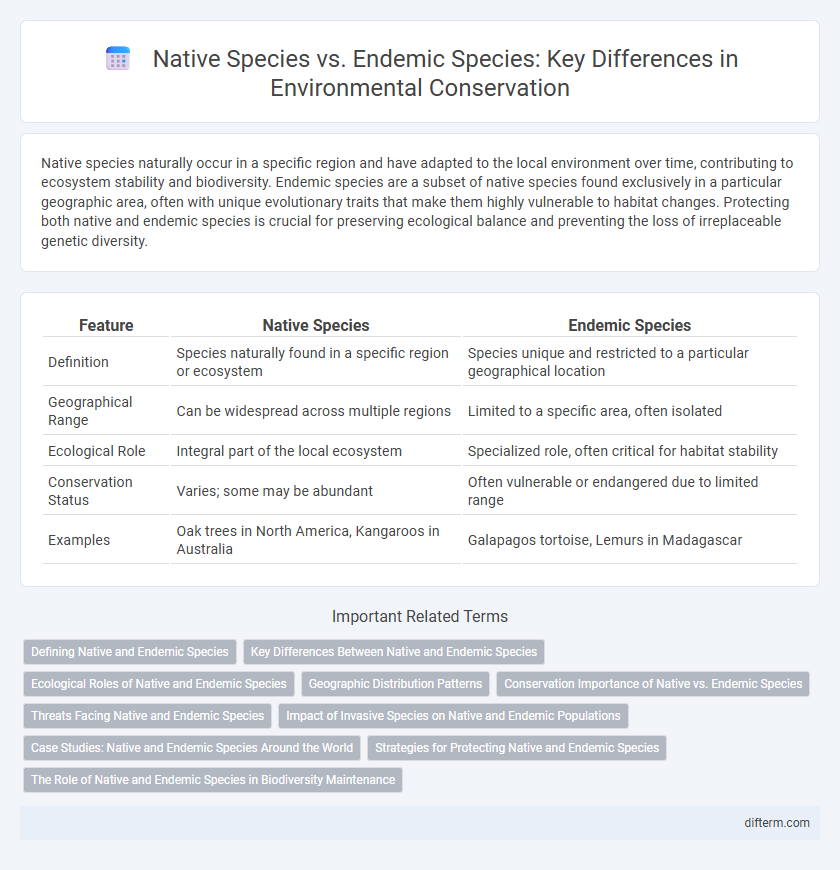Native species naturally occur in a specific region and have adapted to the local environment over time, contributing to ecosystem stability and biodiversity. Endemic species are a subset of native species found exclusively in a particular geographic area, often with unique evolutionary traits that make them highly vulnerable to habitat changes. Protecting both native and endemic species is crucial for preserving ecological balance and preventing the loss of irreplaceable genetic diversity.
Table of Comparison
| Feature | Native Species | Endemic Species |
|---|---|---|
| Definition | Species naturally found in a specific region or ecosystem | Species unique and restricted to a particular geographical location |
| Geographical Range | Can be widespread across multiple regions | Limited to a specific area, often isolated |
| Ecological Role | Integral part of the local ecosystem | Specialized role, often critical for habitat stability |
| Conservation Status | Varies; some may be abundant | Often vulnerable or endangered due to limited range |
| Examples | Oak trees in North America, Kangaroos in Australia | Galapagos tortoise, Lemurs in Madagascar |
Defining Native and Endemic Species
Native species are organisms that naturally occur and have established populations within a specific geographic region without human introduction. Endemic species are exclusively found in a particular area or ecosystem and nowhere else in the world, often resulting from long-term isolation. Understanding the distinction between native and endemic species is crucial for biodiversity conservation and habitat preservation efforts.
Key Differences Between Native and Endemic Species
Native species naturally occur in multiple regions or ecosystems without human introduction, adapting to various local environmental conditions. Endemic species are restricted to a specific geographical area and found nowhere else on Earth, making them more vulnerable to habitat changes. Conservation efforts prioritize endemic species due to their limited distribution and heightened extinction risk.
Ecological Roles of Native and Endemic Species
Native species contribute to ecosystem stability by supporting food webs, pollination, and nutrient cycling across multiple habitats they naturally inhabit. Endemic species, limited to specific regions, often fulfill unique ecological roles crucial for maintaining local biodiversity and ecosystem functions. The loss of either can disrupt ecosystem balance, highlighting the importance of conserving both native and endemic species for environmental resilience.
Geographic Distribution Patterns
Native species are organisms naturally occurring in a particular region, whereas endemic species exist exclusively within a specific geographic area, often limited to isolated habitats like islands or mountain ranges. Geographic distribution patterns of native species typically span broader regions due to ecological adaptability, contrasting with the restricted ranges of endemic species influenced by evolutionary history and environmental barriers. Understanding these spatial dynamics aids in conservation planning by highlighting areas of unique biodiversity vulnerability and ecosystem specificity.
Conservation Importance of Native vs. Endemic Species
Native species contribute to ecosystem stability by supporting complex food webs and maintaining natural processes across broad regions. Endemic species, restricted to specific habitats, hold critical conservation importance due to their vulnerability to habitat loss and environmental changes. Protecting endemic species ensures the preservation of unique genetic diversity essential for ecosystem resilience and evolutionary processes.
Threats Facing Native and Endemic Species
Native species face habitat loss, invasive species, and climate change, which disrupt their ecological roles and reduce biodiversity. Endemic species, restricted to specific geographic areas, are especially vulnerable to extinction due to limited distribution and habitat fragmentation. Conservation efforts must prioritize protecting critical habitats and mitigating human-induced environmental pressures to preserve both native and endemic species.
Impact of Invasive Species on Native and Endemic Populations
Invasive species disrupt native and endemic populations by outcompeting them for resources, altering habitats, and introducing diseases. Native species, which naturally occur in an ecosystem, often lack defenses against these aggressors, leading to population declines and reduced biodiversity. Endemic species, restricted to specific geographic areas, face heightened extinction risks due to their limited ranges and specialized habitat requirements when invasive species invade.
Case Studies: Native and Endemic Species Around the World
Native species occur naturally in multiple regions, adapting to diverse ecosystems, while endemic species are restricted to specific locations, often islands or isolated habitats, making them more vulnerable to environmental changes. Case studies like the koala in Australia demonstrate native species thriving across vast areas, whereas the Madagascar lemurs highlight endemic species with limited distribution requiring focused conservation efforts. Understanding these distinctions aids in prioritizing habitat protection and biodiversity management worldwide.
Strategies for Protecting Native and Endemic Species
Protecting native and endemic species requires targeted conservation strategies such as habitat preservation, invasive species control, and legal protection measures. Restoring ecosystems through reforestation and controlled burns enhances biodiversity and supports species survival. Monitoring population trends using advanced technologies like GIS and remote sensing helps prioritize interventions for critically endangered species.
The Role of Native and Endemic Species in Biodiversity Maintenance
Native species contribute to ecosystem stability by providing essential functions such as nutrient cycling and habitat structure, supporting a wide range of organisms. Endemic species, restricted to specific geographic areas, play a critical role in maintaining genetic diversity and ecological uniqueness, often adapting to specialized niches. Protecting both native and endemic species is vital for preserving biodiversity, as their presence ensures resilience against environmental changes and invasive threats.
native species vs endemic species Infographic

 difterm.com
difterm.com